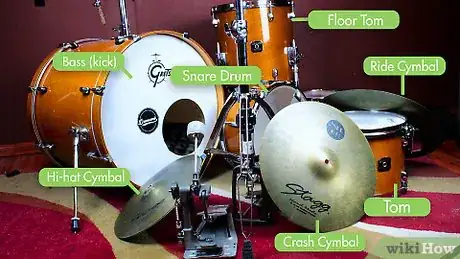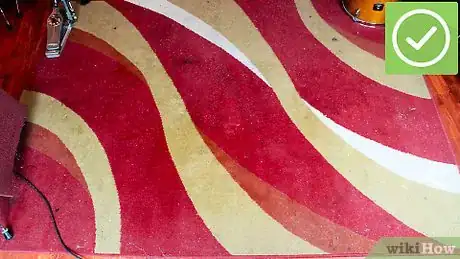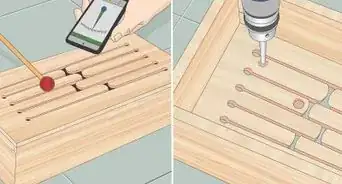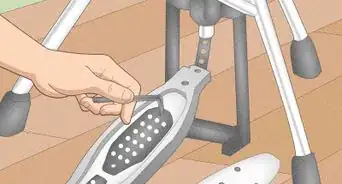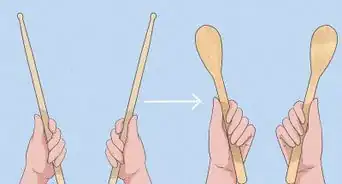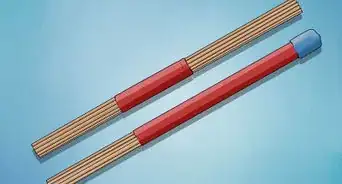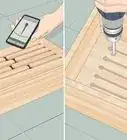wikiHow is a “wiki,” similar to Wikipedia, which means that many of our articles are co-written by multiple authors. To create this article, 32 people, some anonymous, worked to edit and improve it over time.
The wikiHow Video Team also followed the article's instructions and verified that they work.
This article has been viewed 393,220 times.
Learn more...
The drum set is one of the coolest parts of any band, but there sure are a lot of pieces to put together before you can start jamming! When it comes to drum kits, the perfect setup is whatever makes playing feel easy and natural for you. This being said, most kits are set up in a standard, balanced way that most drummers find easy to work with. If you’re looking for the best way to orient your drum set, you’re in the right place. In this article, we’ll show you exactly how to piece it together from the bass drum to the high-hat so you can spend less time setting up and more time rocking out. Let’s get started!
Steps
Getting Organized
-
1Gather all the necessary pieces for your drum set. In addition to the drums and cymbals themselves, you'll also want to make sure you have a small but important tool called a drum key handy. This tool is used to tighten and loosen some of the smaller bolts in the drum kit and is essential if you ever need to disassemble one of the drums (like, for instance, if you need to replace a head). For a standard-size drum kit, your kit will probably include most, if not all, of the following drum pieces:
- Snare drum
- Bass (kick) drum (with pedal)
- Hi-hat cymbal (with pedal)
- Crash cymbal
- Ride Cymbal
- Toms and/or floor tom
- Throne (the "stool" you sit on)
-
2Find a suitable area to set up your drum set. You'll want an area with enough room that you'll be able to set up your drum without crowding the pieces together. When you play, you should be able to make fluid, natural movements. Positioning your pieces too close together can make playing somewhat difficult and can even negatively impact your sound (like, for instance, if a cymbal bangs into an adjacent drum when it's struck).
- Though drum sets with different numbers of pieces will naturally take up different amounts of space, a good rule of thumb is that a given area of floor is big enough for your kit if you can lay on the ground spread-eagle without touching anything.
Advertisement -
3Take the opportunity to perform any maintenance now. Before you begin to assemble your drum set, you may want to give your pieces a quick once-over to look for any problems that may require maintenance. If you spot anything that's out of order, you'll want to address these problems now, rather than later, as disassembling your entire drum kit to perform maintenance on some small part can be a tremendous pain. Below are just a few common issues you may want to look for:
- Worn-out drum heads
- Squeaky kick drum pedals
- "Bald" rubber support feet
- Dust and grime buildup from normal use
Assembling the Drums
-
1Position your bass drum centrally. The bass drum is the first drum you'll set up - from this, you'll build up the rest of the drum set. Set the bass drum on the floor vertically so that the outer head (which usually contains the logo or brand name) faces away from where you intend to sit.[1]
-
2Install the bass drum's legs. Grab the two metal legs that attach to the bass drum and slip them into the holes on either side of the drum. Tighten the brackets hold by turning the knobs. Be sure that the legs reach all the way to the ground and are angled slightly forward so that they can support most of the drum's weight as you press on the foot pedal. Some drum sets will come with pre-attached legs that you must loosen, drop to the floor, and then tighten.
- Note that some bass drum legs will have spikes on the tips and others will have rubber 'feet'. For carpeted floors, you can use either, but avoid using spiked legs on a hard surface such as wood flooring, as these can leave gouges and marks.
-
3Install the kick drum pedal. Usually, the foot pedal you use to play the kick drum is secured to the bottom edge of the bass drum with a screw-on "bracket". Slip the bottom edge of the foot pedal assembly under the bottom center of the bass drum, then tighten the upper part of the pedal assembly by turning its screw. The pedal should "clamp" onto the bottom edge of the bass drum, holding itself in place.[2]
- Other pedal configurations (like double bass pedals) will have more complex assembly processes. Consult any instructions included with your pedals for more information.
-
4Place your throne behind the bass drum and adjust it to the proper height. Use the knob or lever underneath the cushion of your throne to make the throne taller or shorter. Test different heights by sitting on the throne and giving your kick drum a few hits with the pedal. This should be comfortable and easy. Most drummers play with their knees bent at approximately a 90 degree angle.
- However, other arrangements are possible - almost any throne height is fine if it allows you to play easily and hit the kick drum without pushing it forward.
-
5Assemble the snare drum in its stand. The snare drum usually sits in a short stand with three adjustable horizontal arms that hold it in place - usually, the ends of these arms are rubberized to keep the snare from moving while you play it. The stand itself is fairly easy to set up - simply spread the legs at the bottom so that the stand stays upright and use the mechanism at the top to lift and adjust the angles of the arms.[3]
- The snare should sit securely in the stand's arms at a roughly horizontal angle, though, again, any positioning that's comfortable for you is valid. For instance, Daru Jones, a drummer who has toured with artists including Jack White, plays his drums in an unconventional arrangement, with some of his drums slanted downward toward the floor.
-
6Adjust the snare to a comfortable height. Loosen the main nut on the snare stand to adjust its height via the telescoping central column. You'll want your snare at a level that allows you to play it without hitting your legs. This is usually a little higher than the tops of your knees.
- For most rock-style playing, you'll want the snare to sit in front of and slightly to the left of the kick drum so that you can hit it with the left hand stick (assuming a right-handed setup) with the stick nearly flat. This allows for a good crack and the ability to make a 'rim-shot' hit as needed.
-
7Mount the toms on the bass drum. Most bass drums include a metal bracket on top that will allow you to mount two toms in a way similar to how you mounted the bass drum's legs. Usually, there will be two separate holes on top of the bass drum - one for each tom's metal mounting pole. Sometimes there may only be one hole, in which case you'll have to mount both toms on one central pole. Note that the precise way that the Toms attach may differ between drum brands, so make sure to check any included factory set-up instructions if you are unsure of how to proceed.[4]
- The precise positioning of the toms is a personal preference. However, you should make sure they are positioned close enough and at a proper angle to allow quick switching between toms when seated (usually this means you'll want the heads angled towards you and slightly towards each other).
-
8Attach the floor tom's legs and position it in a suitable spot. Most floor toms have long, thin metal legs with rubber feet and a small "bend" so that the feet can be offset from the edges of the drum. Loosen the knobs on the side of the floor tom and insert the legs (feet facing down). Tighten the nuts so that the drum sits slightly above the feet and is well-balanced. Sit in the throne and give it a few good hits to ensure it won't move while you play it.
- Usually, assuming a right-handed set up, the floor tom sits in front of and to the right of the bass drum so that it can be comfortably hit with the right hand.
-
9Make the height of the Floor Tom equal or close to that of the snare. You'll want to be able to to hit your floor tom without any unnecessary effort, so adjust its legs until it's roughly horizontal and roughly at the level of your snare drum.
- Of course, as mentioned above, if an alternate positioning makes it easier for you to play, feel free to use it.
Adding the Cymbals
-
1Unfold the hihat stand and add the bottom cymbal. The hi hat stand is a straight, medium-height one that usually has an attached pedal and three legs at the bottom. Spread the legs out to give the hihat a wide base of support. Then, slide the bottom hihat cymbal on top of the hihat stand so that the "cupped" side points up. Usually, this means you'll have to thread the narrow top part of the high hat stand through the hole in the center of the cymbal. This cymbal just sits in its place - it does not screw into anything.
- If you're having trouble telling the difference between the top and bottom hihat cymbals, usually, the top cymbal will bear the name and logo of the manufacturer, while the bottom one will be relatively unmarked. Often, the two cymbals are essentially constructed identically, so you may not even need to worry.
-
2Install the top hihat cymbal. Unscrew the bottom nut on the hihat clutch - this is what holds the top hihat cymbal to the hihat stand. Place the top hihat cymbal between the 2 felt pads inside the hihat Clutch. Screw the nut back on the bottom and put the hihat clutch onto the hihat stand. Test the hihat by hitting while pressing the pedal. It should produce a thin "click" when the pedal is pressed down and a loud "hiss" the pedal isn't pressed down.[5]
- Usually, the hihat sits to the left of the snare so that it can be hit with the right hand stick (which "crosses over" the left hand stick on the snare). The pedal is usually pressed with the left foot.
-
3Install the ride cymbal on its stand. Usually, the ride cymbal comes with a stand that has a curved base with three supporting legs and an upper portion that stands at an angle. Spread the legs to support the stand, then unscrew the nut at the top of the stand and position the ride cymbal between the two felt pads. Re-tighten the nut, but not too tight - the cymbal should be allowed to "swing" if it's hit hard. Finally, tighten the knob and adjust the height of the cymbal to a comfortable level.
- Generally, the ride cymbal is positioned on the right side of the drum kit, over and behind the floor tom and the bass drum. The cymbal itself usually hangs over the floor tom somewhat, though not enough to impede access to the drum.
-
4Install the crash and any other cymbals. Most standard drum kits also come with at least one crash cymbal. The stand for this cymbal may have an adjustable arm like that of the ride cymbal or may simply sit straight up and down. Regardless, the crash cymbal is installed in basically the same way as the ride. Don't forget to keep from re-tightening the nut too tightly - it's important for cymbals to be able to move fairly freely.
- The crash usually is positioned on the left side of the drum kit, over and behind the bass drum and hihat. Any additional cymbals are usually spaced around the sides and back of the kick drum.
-
5Test your drum kit out. Congratulations - assuming it has no additional accessories, your drum kit should be completely set up. Give it a quick test to ensure that all the pieces are properly-positioned and in working order. Make sure that you can reach every piece of the kit so that you can perform fills without any difficulty.
- Some drummers like to customize their setup with additional drums and accessories. Below are just a few common options you may want to consider:
- Double bass pedals
- Cowbells/Jam blocks
- Additional toms (sometimes tuned to specific notes)
- Chimes, bells, and other auxiliary percussion instruments
- Some drummers like to customize their setup with additional drums and accessories. Below are just a few common options you may want to consider:
-
6Be creative. Being a good drummer involves creating your own style. All of the greats play their own way and have their kits set up a different way. Always experiment with what you have, just don't go too crazy that you can't play. If you can make it work, then you can do it!
Community Q&A
-
QuestionDo ride and crash cymbals have different stands? If so, what is the difference?
 Community AnswerYes and no. They can both be used on the same stands, but ride cymbal stands often have a boom arm on the stand, which allows the cymbal to stretch out over the bass drum.
Community AnswerYes and no. They can both be used on the same stands, but ride cymbal stands often have a boom arm on the stand, which allows the cymbal to stretch out over the bass drum. -
QuestionHow do I fix a snare drum pedal?
 Community AnswerDid you mean bass-drum pedal? If so, then it all depends on what is broken/needs to be replaced. Take it into your local music shop.
Community AnswerDid you mean bass-drum pedal? If so, then it all depends on what is broken/needs to be replaced. Take it into your local music shop. -
QuestionHow do I adjust a Hi-Hat pedal?
 Community AnswerRaise the top of the Hi-Hat a little bit (two fingers maybe), turn the screw, and press the pedal.
Community AnswerRaise the top of the Hi-Hat a little bit (two fingers maybe), turn the screw, and press the pedal.
Warnings
- If you plan to record other instruments in the room that you keep your drumset in, remember to unclip the snare wire. Otherwise you may find a 'crackling' reverberation in the background of your recording. Leaving the snare wire in the 'close' position may ruin your recordings.⧼thumbs_response⧽
- If you have a wooden drum set do not put it in a very humid area this could cause major damage to the wood. This also includes cleaning your wooden set with any water.⧼thumbs_response⧽
- This being a loud instrument, be sure you have some way to dampen the sound if you plan to play when others are present and may not wish to listen to you play.⧼thumbs_response⧽
- This is a loud instrument, so be sure you have ear protection. Without them hearing problems can occur.[6]⧼thumbs_response⧽
References
- ↑ http://drummagazine.com/back-to-basics-how-to-set-up-your-drums/
- ↑ https://www.youtube.com/watch?v=R30P6Yr1IF4
- ↑ http://drummagazine.com/back-to-basics-how-to-set-up-your-drums/
- ↑ https://www.youtube.com/watch?v=l6shjv37cDU
- ↑ https://www.youtube.com/watch?v=UZ1IMBoGHu4
- ↑ http://drummagazine.com/health-tips-i-cant-hear-you/
About This Article
To set up a drum kit, start by positioning the bass drum centrally, so you can build the rest of the drums around it. Next, install the bass drum’s legs and attach the kick drum pedal to the bottom. Then, assemble the snare drum in its stand and place it slightly to the left of the bass drum. After that, mount the toms on top of the bass drum, then attach the floor tom’s legs and position it to the right of the bass drum. Finally, adjust the height of your stool and all of your drums so you can play comfortably. For more tips, like how to add cymbals to your drum kit, read on!
